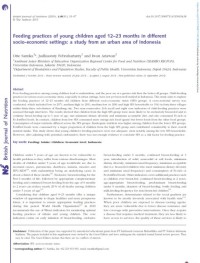Feeding practices of young children aged 12-23 months in different socio-economic settings: a study from an urban area of Indonesia

Author
Judhiastuty Februhartanty - Personal NameIwan Ariawan - Personal Name
Otte Santika - Personal Name
Abstract:
Poor feeding practices among young children lead to malnutrition, and the poor are at a greater risk than the better off groups. Child-feeding practices in various socio-economic strata, especially in urban settings, have not yet been well studied in Indonesia. This study aims to explore the feeding practices of 12-23 months old children from different socio-economic status (SES) groups. A cross-sectional survey was conducted, which included low (n 207), medium-high (n 205), medium-low (n 208) and high SES households (n 194) in forty-three villages within thirty-three sub-districts of Bandung city. Two non-consecutive 24 h recall and eight core indicators of child-feeding practices were assessed through interviews. The results showed that children from the high SES group were more likely to be exclusively breast-fed and to continue breast-feeding up to 1 year of age, met minimum dietary diversity and minimum acceptable diet, and also consumed Fe-rich or Fe-fortified foods. In contrast, children from low SES consumed more energy-rich food (grain) but fewer foods from the other food groups. Consumption of major nutrients differed across the SES groups. Inadequate nutrition was higher among children from the lower SES groups. Fortified foods were consumed by a larger proportion of children from the high SES group and contributed considerably to their overall nutrient intake. This study shows that young children's feeding practices were not adequate, most notably among the low SES households. However, after adjusting with potential confounders, there was not enough evidence to conclude SES as a risk factor for feeding practice.
Detail Information
| Series Title | : | - |
| Call Number | : | - |
| Publisher | : | : Br J Nutr., 2016 |
| Collation | : | Br J Nutr . 2016 Jul:116 Suppl 1:S1-7 |
| Language | : | English |
| ISBN/ISSN | : | - |
| Classification | : | NONE |
 Computer Science, Information & General Works
Computer Science, Information & General Works  Philosophy & Psychology
Philosophy & Psychology  Religion
Religion  Social Sciences
Social Sciences  Language
Language  Pure Science
Pure Science  Applied Sciences
Applied Sciences  Art & Recreation
Art & Recreation  Literature
Literature  History & Geography
History & Geography